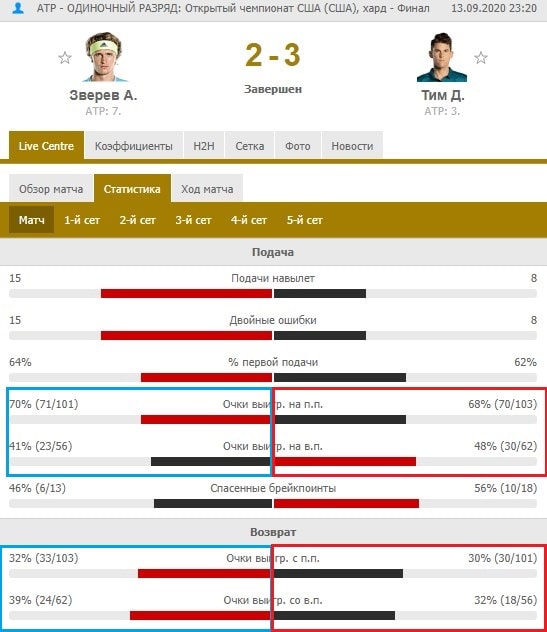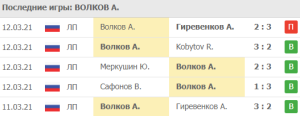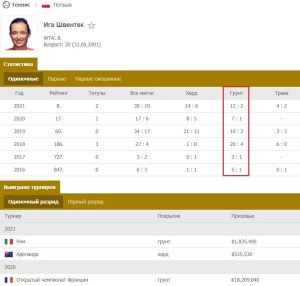
Betting strategies are used not only by novice users, but also by experienced bettors. Some are based on the form and readiness of the participants in the event, while others are based solely on statistical indicators. The SetPoint tennis betting strategy will help you fill the pot, but for a positive outcome you have to tinker with numbers and calculations.
Other sports betting strategies can be found in the section of the same name.
Content
- The essence of the strategy
- Example strategy
- conclusions
The essence of the strategy
The strategy is based on the fact that the average number of tennis players' points per match is calculated, and then the probability of victory for each of the athletes is analyzed.
For the convenience of calculations, it is advisable to take a segment of the last five matches. This will optimize the counting process and give optimal numbers for a specific segment of the season.
First, you need to find the average score for the first tennis player. To do this, add up the won balls for the five previous matches – for example: 63 + 70 + 44 + 56 + 67 = 300. The won balls is the number of points that the player earned in one match. They are obtained by adding up the points won at the service and at the reception. Then the resulting number is divided by the number of analyzed matches – 300/5 = 60.
To find the number of points won per match, you should turn to statistical resources and make the necessary calculations. Zverev's glasses are highlighted in blue, Tim's glasses are highlighted in red.
 Photo source: flashscore.ru
Photo source: flashscore.ru
You can also count points manually. To do this, you need to find the number of balls won in each separate game and add them up. For example, the first game was won with a score of 40:30 and brought 4 points. The second was lost after 40:40 and more / less 2 times – 5 points, the third was lost with a score of 30:40 – two points. By adding up the points scored in each of the games played per game, we get the total number of balls won by the tennis player.
Then a similar procedure is carried out for the second tennis player. For example: 44 + 46 + 51 + 50 + 69 = 260, 260/5 = 52.
After that, the average coefficient of the match is calculated, the average points of the favorite must be divided by the average points of the outsider. 60/52 = 1.153.
Then it remains to carry out simple calculations to calculate the chances of the final success of each of the rivals. The average score for tennis players will be (60 + 52) / 6 = 56.
For the favorite, this number is multiplied by the resulting coefficient – 56 * 1.153 = 64.6 points. The first player must win 65 goals in a match.
The resulting figure is rounded to the nearest integer in accordance with mathematical rules
For an outsider, the calculation is carried out by dividing – 56 / 1.153 = 48.6 points.
After that, the probability of winning for each of the tennis players is analyzed: the first player – 65 / (65 + 49) = 0.57, the second player – 49 / (65 + 49) = 0.43. We get a probability ratio of 57% – 43%.
The last step is to analyze the desired coefficient, which is obtained by dividing one by the probability of each tennis player winning (57% = 0.57). Then, the favorite's victory should be estimated – 1 / 0.57 = 1.75. We get the standard quote, which should be used to evaluate the favorite. Therefore, if higher odds are set for the first tennis player, the bettor should definitely take advantage of this.
Example strategy
Long explanations and numerous calculations are best analyzed with a specific example. For analysis, let's take the upcoming duel in which Khachanov and Ruud will meet.
We calculate the average points of Khachanov: 54 + 89 + 181 + 94 + 132 = 550, 550/5 = 110. Total, 110 points per match.
We calculate the average points of Ruud: 56 + 76 + 157 + 80 + 73 = 442, 442/5 = 88.4. In total, 88 points for the fight.
110/88 = 1.25 is the average game rate, and then we calculate the tennis players' chances based on the average points. (110 + 88) / 2 = 99.
Khachanov – 99 * 1.25 = 123.75, Ruud – 99 / 1.25 = 79.2. The probabilities of victory are calculated by analogy with the example, for Karen – 61%, for Ruud – 39%. We get the coefficient for Khachanov at 1.64 (1 / 0.61). Bookmakers estimated the possible victory of a tennis player from Russia at about ~ 1.9. This is more than the estimated figure, so you can safely bet on Khachanov.
Photo source: flashscore.ru
conclusions
The Setpoint strategy is ideal for bettors who like to base their bets on statistics. But it does not take into account the current state of the athlete, as well as possible in-game factors – tennis player injury, poor health. The user will have to monitor these indicators additionally.


